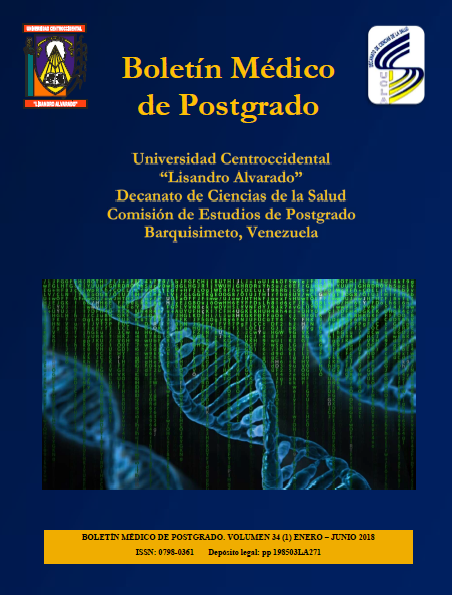Usefulness of the Quick-SOFA score in the diagnosis of sepsis in pediatric patients. Servicio Desconcentrado Hospital Pediátrico Dr. Agustín Zubillaga
Keywords:
sepsis, organ dysfunction scores, pediatrics, infectionAbstract
The Quick-SOFA score (qSOFA) has not been designed for use in children, although it has been used in numerous studies as a marker of organic dysfunction in sepsis in the absence of a proper score. In order to determine the usefulness of the Quick-SOFA score in the diagnosis of sepsis in pediatric patients who were attended at the Servicio Desconcentrado Hospital Pediátrico Dr. Agustín Zubillaga during the period March-April 2018, a cross-sectional descriptive study was conducted with a total of 60 patients with an average age of 3.03 + 3.76 years of age, predominantly younger infants (40%) as well as male sex (63.3%). The main sites of infection were respiratory (41.6%) and digestive (31.6%). 61.6% of patients had a Glasgow value > 13 points, 68.3% had an elevated respiratory rate and 55% had a systolic blood pressure lower than the percentile for their age. Overall, 75% reported a qSOFA > 2 points and 38.3% presented sepsis. 37.7% of patients with sepsis had a score > 2 and 40% less than 2 points. In this study, qSOFA had a sensitivity of 73.9%, specificity of 24.3%, positive predictive value of 37.78% and negative predictive value of 60%. qSOFA is a simple scale which can facilitate the adequate stratification of risk in pediatric patients with sepsis.
Downloads
References
2. Singer M, Deutschman C, Seymour C, Shankar M, Annane D, Bauer M, et al. The Third International Consensus Definitions for Sepsis and Septic Shock (Sepsis-3). JAMA 2016; 315(8): 801-810.
3. Seymour C, Liu V, Iwashyna T, Brunkhorst F, Rea T, Scherag A, et al. Assessment of clinical criteria for sepsis: for the Third International Consensus Definitions for Sepsis and Septic Shock (Sepsis-3). JAMA 2016; 315(8): 762-74.
4. Neira E, Málaga G. Sepsis-3 y las nuevas definiciones, ¿es tiempo de abandonar SIRS? Acta Med Perú 2016; 33(3): 217-222.
5. Shankar M, Phillips G, Levy M, Seymour C, Liu V, Deutschman C, et al. Developing a new definition and assessing new clinical criteria for septic shock: for the Third International Consensus Definitions for Sepsis and Septic Shock (Sepsis-3). JAMA 2016; 315(8): 775-787.
6. Torné E. Revisión de las nuevas definiciones sobre la sepsis y su aplicación en Pediatría. Revista Española de Pediatría 2017; 73(Supl. 1): 21-22.
7. Hoyos A, Díaz A, Suarez L, Álvarez A. Factores de riesgo: un reto en la evaluación de los niños febriles. Medimay 2013; 19(3): 1-9.
8. Bourillon A, Benoist G. Infecciones bacterianas del niño. EMC - Tratado de Medicina 2015; 19(2): 1-13.
9. Torregrosa C, García C, Sciarotta J, Vay C, Caino S, Ellis A. Factores asociados a riesgo de infección bacteriana grave en niños bajo 24 meses de edad, internados por fiebre sin foco aparente. Revista Chilena de Infectología 2010; 27(4): 308-314.
10. De Carlos J. ¿Debemos adoptar nuevas recomendaciones en el manejo actual de la sepsis? Rev. Esp. Pediatr 2017; 73(Supl. 1): 23-27.
11. Ochoa X, Cano A, Tapia E, López F, Pérez G, Sánchez A, et al. Validación de la nueva definición de sepsis en el servicio de urgencias. Anales Médicos 2018; 63(1): 6-13.
12. Freund Y, Lemachatti N, Krastinova E, Van Laer M, Claessens Y, Avondo A, et al. Prognostic Accuracy of Sepsis-3 Criteria for In-Hospital Mortality among Patients with Suspected Infection Presenting to the Emergency Department. French Society of Emergency Medicine Collaborators Group. JAMA 2017; 317(3): 301-308.
13. Giamarellos E, Tsaganos T, Tsangaris I, Lada M, Routsi C, Sinadipis D, et al. Validación de las nuevas definiciones de Sepsis-3: propuesta de mejora en la identificación temprana del riesgo. Clin Microbiol Infect 2017; 23 (2): 104-109.
14. Askim Å, Moser F, Gustad L, Stene H, Gundersen M, Åsvold B, et al. Desempeño deficiente de SOFA rápido (qSOFA) en la predicción de septicemia grave y mortalidad-un estudio prospectivo de pacientes ingresados con infección en el servicio de urgencias. Scand J Trauma Resusc Emerg Med 2017; 25 (1): 56.
15. Churpek M, Snyder A, Han X, Soko S, Pettit N, Howell M, et al. Quick Sepsis-related Organ Failure Assessment, Systemic Inflammatory Response Syndrome, and Early Warning Scores for Detecting Clinical Deterioration in Infected Patients outside the Intensive Care Unit. AJCCM 2017; 195(7).
Published
How to Cite
Issue
Section
Las opiniones expresadas por los autores no necesariamente reflejan la postura del editor de la publicación ni de la UCLA. Se autoriza la reproducción total o parcial de los textos aquí publicados, siempre y cuando se cite la fuente completa y la dirección electrónica de esta revista. Los autores(as) tienen el derecho de utilizar sus artículos para cualquier propósito siempre y cuando se realice sin fines de lucro. Los autores(as) pueden publicar en internet o cualquier otro medio la versión final aprobada de su trabajo, luego que esta ha sido publicada en esta revista.



